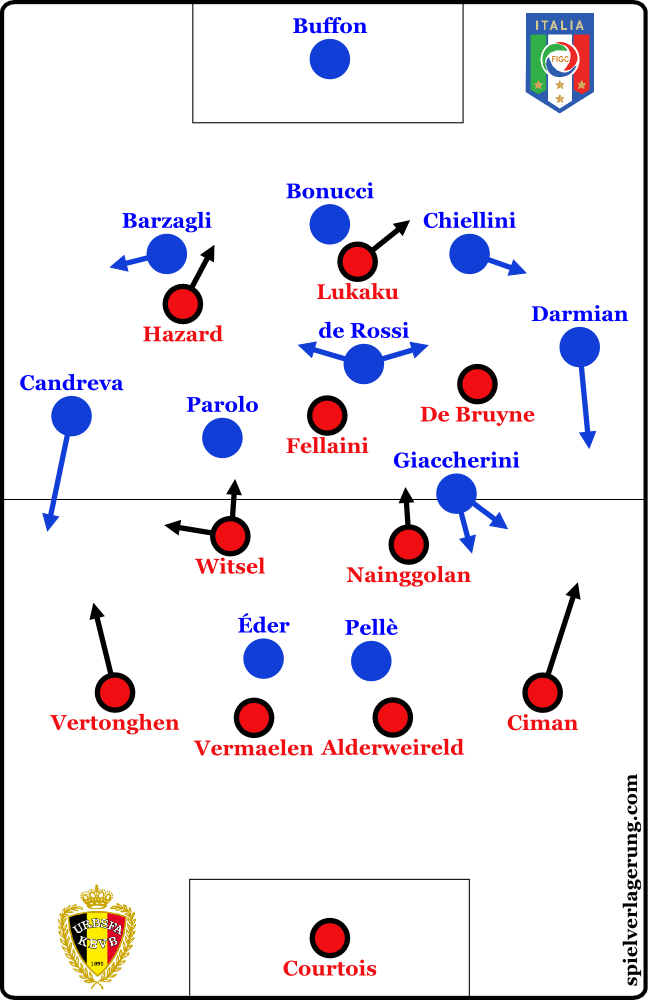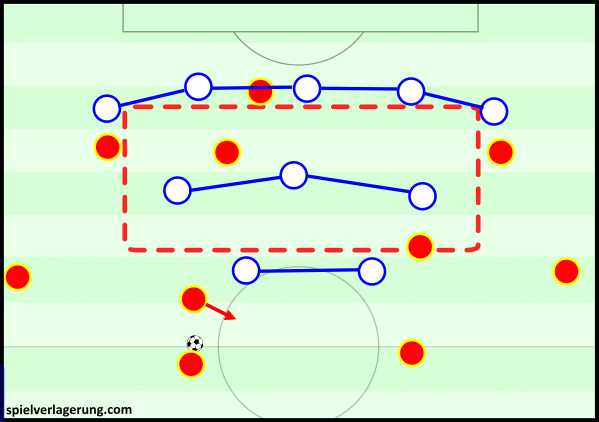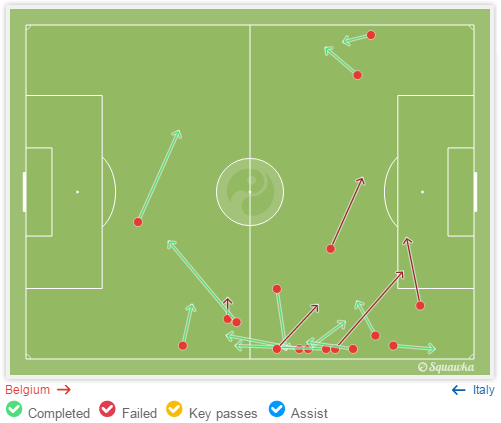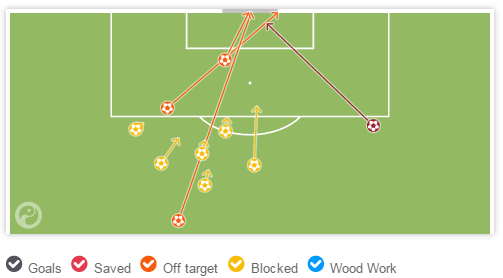Wilmots’ rigid tactics limit creativity in Italy defeat
Tactics beat individualism. Experience breaks talent. That’s what you will read after a match like this. And to some extent it seems to be true. Not many bet their money on an Italian win, but Antonio Conte’s pulled off the upset.
 Formations
Formations
The Italian coach stuck to his well-known 3-5-2 formation, with the three Juventus defenders at the back, Daniele De Rossi in the holding role and Éder playing alongside Graziano Pellè up front. Moreover, Conte decided to field Antonio Candreva as a wing-back, while leaving Alessandro Florenzi on the bench. In central midfield, Marco Parolo and Emanuele Giaccherini were used as box-to-box runners, covering the space next to De Rossi in defence and supporting both centre-forwards in offense.
Belgium’s coach Marc Wilmots chose a conservative system, as he fielded Marouane Fellaini in the no. 10 role. Kevin De Bruyne and Eden Hazard played on the flanks, supported by both full-backs, Laurent Ciman and Jan Vertonghen. That meant Wilmots, as expected, broke up the Tottenham centre-back pairing, as Barcelona’s Thomas Vermaelen defended alongside Toby Alderweireld in the middle of the back line.
Italy bridge long distance
Belgium not only employed a 4-2-3-1 when building up, they also defended in a 4-2-3-1, with what looked like a wide diamond up front. Fellaini usually man-marked De Rossi, while both wingers waited for Giorgio Chiellini and Andrea Barzagli to advance and play the ball down the flank. Italy, however, preferred long vertical or diagonal balls. The three centre-backs circulated the ball for quite a while before they either knocked the ball towards Éder and Pellè or played a long high pass to one of the wing-backs.
Belgium defended man-orientated in the middle, yet their full-backs were normally positioned close to the centre-backs, so both Italian wing-backs had some space to receive a pass without feeling too much pressure. From there, they had the chance to continue the play by moving the ball diagonally.
Receiving said diagonal passes or long balls from the defenders, Éder and Pellè were great at dropping a few yards back and playing lay-off passes to each other in front of Alderweireld and Vermaelen. At least one of the more attacking midfielders normally pushed through the half-space to provide a second option for the ball-carrier or to receive a long ball behind the back line.
Italy’s first goal delivered a great example. Bonucci stood in the centre circle, not being pressured by any Belgium player. Giaccherini, who was already near the opposing the back-line, made a quick run behind Alderweireld who couldn’t deflect Bonucci’s long ball with his head.
Belgium’s centre-midfielders a non-factor
Italy were now in a comfortable situation. Defending in a 3-5-2, they were very precise when shifting towards one flank. Normally, Belgium started their build-up play by moving the ball to one of the full-backs. Then, immediately, Italy’s ball-near centre-midfielder pushed forward, changing his team’s system into a 5-2-3, while blocking diagonal passing lanes, so the ball-carrying full-back could only play the ball down the wing. Although the advancing midfielder exposed a fairly big gap, he was able to cover the gap with his shadow.
Prior to the tournament, Belgium often used this kind of build-up pattern, even without facing a defensive scheme like this. But in yesterday’s match, Wilmots’ team clearly wanted to get the centre-midfielders more involved. One of them occasionally dropped between the centre-backs, while his colleague tried to offer an option behind Éder and Pellè.

Graphic by JD
Axel Witsel and Radja Nainggolan wanted to be more active compared to recent matches, yet they couldn’t figure out the right set-up in the early phases of Belgium’s build-up plays. Therefore, the Red Devils decided to attack through the wings, as per usual.
Unfortunately for them, that prevented De Bruyne from moving centrally. The Manchester City playmaker hugged the touchline most of the time during the first half. Romelu Lukaku often drifted into the right half-space. Against a conventional back four, that could’ve worked quite well, as the 23-year-old would’ve found a gap between the left-sided centre-back and the left-back.

Kevin De Bruyne’s passes in the first half | Squawka.com
Due to Italy’s back five they especially utilised after the beginning of the match, there wasn’t really room for Lukaku to make runs through the wider area of the penalty box. On the other side of the field, Eden Hazard frequently charged towards the offside-line, hoping for diagonal balls getting through to him.
For the most part, Italy stayed relaxed. They weren’t invulnerable, yet, given the result on the score board, Conte’s side were comfortable putting all men behind the ball. Towards the end of the first half, even Pellè supported the midfield line, which turned Italy’s defensive formation into a 5-3-1-1.
Second half
You would expect Wilmots to make adjustments during the half-time break? He didn’t. It took him another 15 minutes before he brought on an additional attacking player in Dries Mertens, moving Fellaini back into a no. 6 role.
Two things in regards to Belgium that stood out in the second half: first, their high block as a tighter unit moved towards the ball in the first phase of pressing. However, the Red Devils weren’t usually able to intercept passes, but left certain zones behind the first block fairly exposed. Second, Belgium conducted too many attacks where they were severely out-numbered in the final third. Often enough, the centre-midfielders and at least one full-back reached the higher zones too late, so Belgium’s attacking players had to hold on to the ball for quite a while in several situations, which was a tough task against a narrow and aggressive Italy team.

Italy’s shots in the second half | Squawka.com
Wilmots brought on Yannick Ferreira-Carrasco as a right-back/right-winger hybrid and Divock Origi as a fresh runner up-front. That didn’t change much as far as the tactical effectiveness went. In the closing phase, Italy put seven or more into the own penalty area. As they often stood on one horizontal line, the space right in front of the box remained unmarked. Yet, Belgium’s shot attempts or attempted through balls were blocked several times. In return, Italy scored a second goal after a counter-attack and closed the show.
Conclusion
SB Nation’s Pardeep Cattry wrote after the match: “Their [Italy’s] strong beginning to the match against a sluggish Belgium made this Italy team look like true competitors for the title of champions of Europe, which is in stark contrast from what was expected of them before their tournament started. In fact, perhaps they are more of a dark horse than their opponent today.”
As we pointed out in our EURO preview, Belgium aren’t as strong as many thought prior to the tournament. Wilmots has a group of highly talented at his disposal. That said, his customary 4-2-3-1 system including easily defendable wing attacks isn’t something that could scare top-tier competition. Blocking the middle of the park and defending a couple of one-on-ones at the back are enough to keep Belgium off of the danger zone.
As for Italy, don’t mess with old-men strength. Gli Azzurri probably lack star power in midfield, because both Claudio Marchisio and Marco Verratti can’t be part of the team due to their injuries. Nevertheless, Conte found a way to out-smart Belgium in some phases of the game.


2 Kommentare Alle anzeigen
Tom V June 16, 2016 um 12:01 pm
I still dont get how people say its a 3-5-2 while most of the time its a 5-3-2 (due to their defensive approach to the game, relying on the counter-attack). Whenever they counter-attacked, they mostly kept 4 at the back, while one of the wingbacks (Damian or Candreva) pushed up all the way to the backline (making a run on the sideline). Thus making it more of an assymetrical “4-3-3”.
Alfie June 15, 2016 um 11:36 am
nice piece!
Italy played incredible smart. I realy love the swinging back four from the first half. It’s such a good tool to pressure wing attacks.